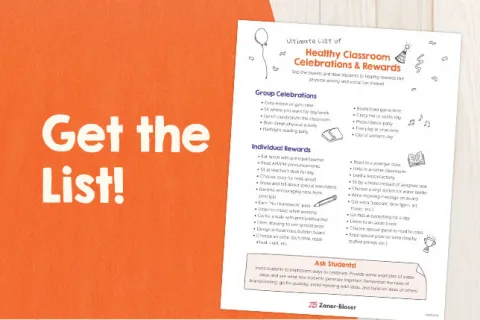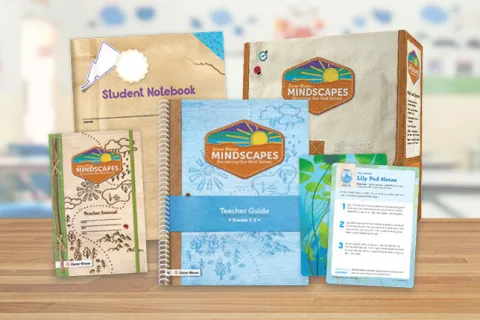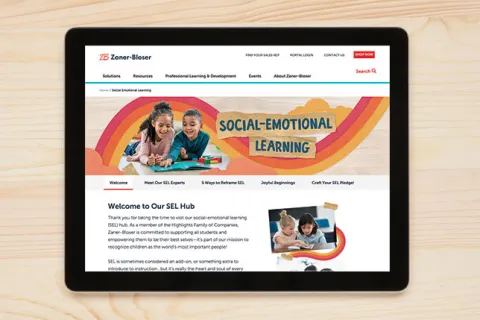
Joyful Beginnings: 5 Ways to Build a Welcoming Classroom Community

Kids have a natural desire to belong in their community and to use their voice to tell their story. These actions create joy, hope, and ultimately opportunities to change the world.
We asked education experts Pam Allyn and Dr. Ernest Morrell how teachers can nurture these desires to build joyful, growth-minded classroom communities. They stressed that community building isn’t only something to do at the beginning of the school year and offered five strategies to use any time.
Create an Environment of Belonging
Learning begins with understanding ourselves and then expands to an awareness of others in our community, and eventually to our role in the larger world. Encouraging students to value themselves is the first step in cultivating a sense of belonging—in the classroom and beyond.
Create Self-Portraits
Self-portraits are one way to build belonging and help students in a classroom get to know one another. Allyn and Morrell suggest inviting students to create a monthly self-portrait. Here’s how it works:
- Use any medium: collage, watercolor, pen or pencil, or digital drawing app.
- Ask students to add words or sentences to their self-portrait that represent who they are, focusing on words that bring them joy: dancer, dog lover, pizza eater.
- Invite younger students to share orally instead of, or in addition to, writing.
- Ask students to include their name—as well as something special about it.
- Return to self-portraits monthly, inviting students to add to or remake them.
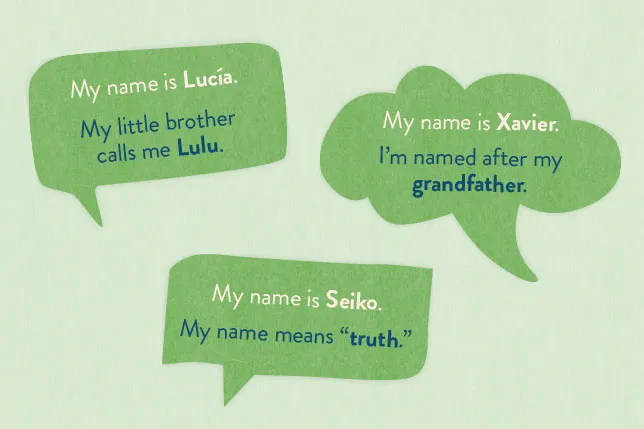
Consider how students might share their self-portraits with the whole class, in small groups, or with a partner. It’s especially important for students to pronounce their name and have it recognized by the class community. This seemingly simple act can go a long way in creating a joyful sense of belonging.
Practice Listening to Hear Everyone’s Voice
It’s important to create a culture of deep listening to ensure every voice is heard in the classroom. In addition to building community, listening practices help students cultivate a valuable life skill. After all, listening—not talking—is our most frequent form of communication!
Co-Create a Listening Mantra
- Start by briefly brainstorming what “deep listening” means.
- Prompt students to recall a time when someone listened deeply to them:
- How did it feel when someone listened deeply to you?
- What does deep listening look like? . . .sound like?
- What qualities make a great listener?
- Invite older students to free write or turn and talk with a partner. Younger students can share aloud.
- Take notes on what your students share. Then work to craft a Listening Mantra based on their ideas that you can post and use in the classroom.
Aim to keep your Listening Mantra simple and memorable. For example: Good listeners are present, positive, and pay attention.
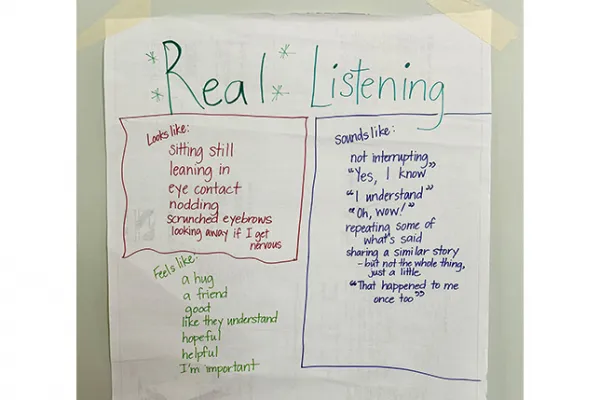
Try a Listening Protocol
Older students can learn a formal practice for listening deeply during any small-group activity.
- While one student shares, others in the group take notes in three areas:
- Something I liked.
- Something I learned.
- Something I want to know more about.
- After the speaker has finished, listeners can share what they noted in each area or choose one of the three areas to discuss if time is limited.
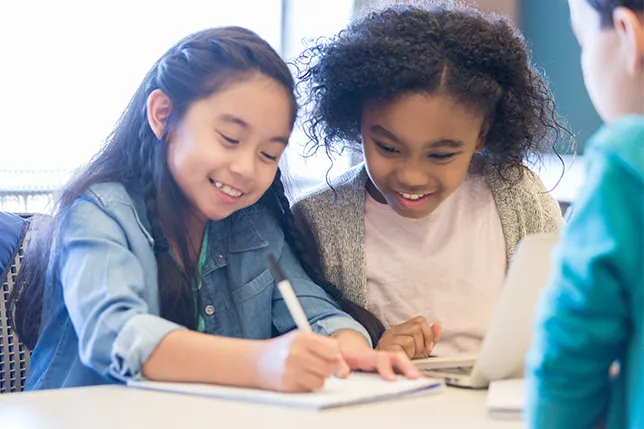
Make Spaces for Students’ Stories
Students often receive stories in the classroom, but it’s equally important that they have opportunities to share stories.
“We’re hearing, listening, speaking, reading, writing. . . all of those literacy skills are woven into that idea of story,” explains Allyn. Students can model the structures they recognize from texts they study in class as they take on the role of storyteller.
Sharing stories not only helps students practice narrative but also enables them to continue building connections and empathy toward one another.
Schedule a Weekly Storytelling Day
- Pick a day of the week for designated storytelling time (such as “Storytelling Fridays”).
- Set aside 10–15 minutes—perhaps during your morning meeting—for storytelling in an “open mic” style.
- Allow as much student choice as possible. Kids can sign up in advance, write down the story beforehand, or bring in an artifact to show while they talk.
By making storytelling a regular ritual in the classroom, you will communicate the value of students’ stories—reinforcing both belonging and community.
Bonus tip: This is a great place to try out the Listening Protocol described above!
Turn Students’ Hopes Into Actionable Goals
As noted at the beginning of this article, learning tends to progress from a focus on oneself to a focus on others and finally to our roles within the larger world. So once students build a sense of belonging, community, and voice, they can explore their hopes. We can support them in thinking about how to turn hopes into reality.
Create a Dreamer’s Window
- Dedicate a bulletin board or poster board for your classroom Dreamer’s Window.
- Use blue paper as a background and strips of brown or white paper to make a window frame.
- Invite students to write or dictate a hope they have for themselves, others, or the world, and then add it to the board. Write it on cloud or star shapes to keep up the sky theme.
- Schedule time—every other month or the end of each term perhaps—to choose one or two hopes that your class can make actionable together.
- Guide students in crafting a simple statement that moves from hope (e.g, “recycle more”) to goal (“recycle paper in our class,” “teach our families about good recycling habits,” or “participate in a park cleanup”).
Allow students to add other hopes—for themselves, others, or the world—throughout the year. As time allows, challenge them to discuss how a selected hope could become an actionable goal in your community or school.
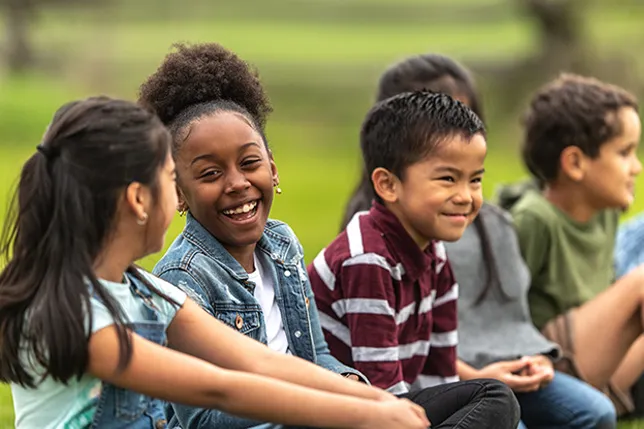
Prioritize Affirmation and Celebration in the Classroom
Celebrating is an important part of learning and belonging. Dr. Morrell notes that the biggest challenge we face in classrooms is low confidence—students not feeling up to the task at hand. Celebration turns that feeling around to make learning joyful. “We don’t have to have stress to have success,” Morrell says.
Make delight and celebration an intentional and frequent part of your classroom community. You don’t need something big to celebrate. . . recognizing the small steps students make throughout the month, week, or even a single day has powerful benefits!
Recognize Growth with Affirmation Cards
- Download a free copy of Zaner-Bloser’s preprinted affirmation cards.
- Print and distribute cards to celebrate students’ growth.
- Award cards publicly, place them on students’ desks during recess, or allow students to distribute the cards to each other.
You can even take a group approach and use affirmation cards as a way to earn a larger celebration! Simply place the cards and a bowl somewhere in the classroom. Invite students to place the appropriate card in the bowl when they notice a peer exhibiting one of the values. When the bowl is full, ask students to brainstorm and suggest a way to celebrate together!
Embrace a Joyful, Strengths-Based Approach to Learning
If you’re looking for more ways to establish vibrant and welcoming learning communities—with a common language across grades K–5—explore more from authors Pam Allyn and Dr. Ernest Morrell in Mindscapes: Becoming Our Best Selves.
You May Also Like
